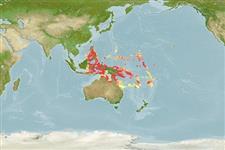Actinopterygii (ray-finned fishes) >
Perciformes (Perch-likes) >
Nemipteridae (Threadfin breams, Whiptail breams)
Etymology: Scolopsis: Greek, skolex = worm + Greek, opsis = appearance (Ref. 45335).
Environment / Climate / Range
Ecology
Marine; reef-associated; depth range ? - 35 m (Ref. 90102). Tropical, preferred ?; 19°N - 23°S, 115°E - 176°W
Western Pacific: Eastern Indonesia, Solomon Islands, Santa Cruz Islands and Fiji. This species closely resembles Scolopsis monogramma, and the two species have been previously confused.
Size / Weight / Age
Maturity: Lm ? range ? - ? cm
Max length : 35.0 cm SL male/unsexed; (Ref. 48635); common length : 20.0 cm SL male/unsexed; (Ref. 3810)
Dorsal
spines
(total): 10;
Dorsal
soft rays
(total): 9;
Anal
spines: 3;
Anal
soft rays: 7. Head scales reaching forward to or just behind level of anterior margin of eye. A small naked area on temporal region behind eye. Lower limb of preopercle scaly. Antrorse (forward-directed) suborbital spine absent. Pelvic fins long, reaching to or beyond level of anus. Upper lobe of caudal fin a little longer then lower lobe. Lobes produced to form filamentous extensions in larger specimens. Color: Upper body bluish, white below. Sides are also bluish. Scales on body with yellow centers forming horizontal lines above lateral line and diagonal lines below. A pinkish-brown stripe from behind eye, arching on back beneath lateral line and terminating behind tip of pectoral fin. Four blue stripes on head.
Inhabits coastal and lagoon waters, on sand rubble bottoms close to reefs. Usually seen solitary in 20+ m depth. May also be seen in groups. (Ref. 48635, 90102)
Life cycle and mating behavior
Maturity | Reproduction | Spawning | Eggs | Fecundity | Larvae
Russell, B.C., 1990. FAO Species Catalogue. Vol. 12. Nemipterid fishes of the world. (Threadfin breams, whiptail breams, monocle breams, dwarf monocle breams, and coral breams). Family Nemipteridae. An annotated and illustrated catalogue of nemipterid species known to date. FAO Fish. Synop. 125(12):149p. Rome: FAO. (Ref. 3810)
IUCN Red List Status (Ref. 115185)
CITES (Ref. 94142)
Not Evaluated
Threat to humans
Harmless
Human uses
Fisheries: subsistence fisheries
More information
Common namesSynonymsMetabolismPredatorsEcotoxicologyReproductionMaturitySpawningFecundityEggsEgg development
ReferencesAquacultureAquaculture profileStrainsGeneticsAllele frequenciesHeritabilityDiseasesProcessingMass conversion
Tools
Special reports
Download XML
Internet sources
